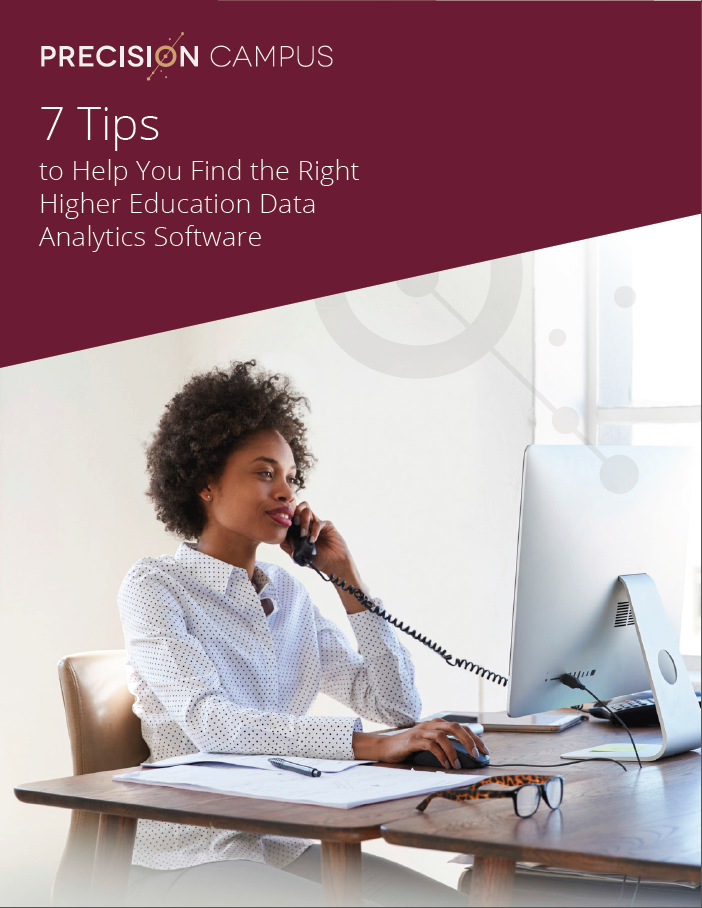The practice of collecting and using information is nothing new, but technology has revolutionized how we collect, store and utilize that data. In fact, every two days we create as much data as we did from the beginning of time until the year 2000 — can you imagine recording all of that information through spreadsheets or handwritten documents?
With the help of big data, colleges and universities are adopting data-driven decision making practices to improve student success, retention rates, resources allocation and more. Here’s everything you need to know about big data analytics in education.
What is Big Data?
“Big data” is a term used to describe the immense amounts of data that is constantly being generated and recorded in the digital age — data that presents game-changing potential for valuable insights into nearly every industry as well as society as a whole.
In terms of analytics, big data is used to examine varied sets of information. For higher education, this can include student demographics such as gender and ethnicity and course data like success rates and resource allocation.
By detecting trends in big data, it’s possible to develop the context needed to determine what may happen in the future. As we mentioned, data itself isn’t new but how we use it is. Here are a few simple ways higher education can put big data to work:
Raise Admissions ROI
When your admissions office is combing through an endless number of applications, what is their process for determining which students to accept?
Your existing data sets can help by telling you which prospective students may be the most likely to enroll and succeed at your institution. On the other hand, you can also use big data to assess trends that can tell you who might be more likely to drop out or fail their classes. Ensuring that new admissions are right for your institution will be valuable for your ROI.
Improve Student Success
With California community colleges now relying on high school performance as opposed to standardized tests for proper course placement (through new legislation known as AB 705), evaluating existing data is more important than ever before.
High school grades, courses and GPAs can tell you if a student will likely succeed in a college-level course or if they may need remediation first. Even in states without their own AB 705, institutions can use students’ high school performance to support them throughout their time at the institution.
Big data analytics can also help you keep track of students throughout their time at your institution. If a student begins to struggle, the advisor can take the necessary steps to intervene and find a solution. This can not only help your student success rates, but it can also prevent students from slipping through the cracks.
Enhance Curriculums
How do you know if your curriculum is effective? Dropout rates are one way to gather the context you need to figure this out. If certain sections of ENG 120 have high dropout rates, use your data to dig deeper. What do the unsuccessful sections all have in common? Are they held very early in the morning? Are they all being taught by the same professor? With a little bit of detective work, you can find commonalities that can help you fix the problem.
Courses with low or fluctuating enrollments can also tell you how student demands are changing. If Introduction to German Language only has one section that has seen a decline in enrollment for the past three semesters, it might be time to sunset that course and spare your resources.
Another avenue to explore is online courses. The demand for online learning has skyrocketed over the past few years and, for many students, whether or not an institution offers these classes is often a deal breaker. Your data can show you which on-campus courses may be struggling and from there you can make it part of your plan of attack to determine if an online option may be a good solution.
Optimize Resources
Let’s say that LIT 200 has five sections for the fall semester. Looking at your data, you find that two of the sections are only half-full. This is a waste of resources, including the classroom utilization and the professor’s time. These two sections could easily be merged or eliminated in future semesters to help you save your valuable resources.
On the flip side, your data can tell you where you might need to bring on additional staff. Since your data shows you enrollment numbers and trends, you’re able to see enrollment fluctuations and waitlist requests. If Introduction to Anthropology has a waitlist that’s a mile long, this is a guaranteed boost to course enrollments if the appropriate number of sections are available. All you may need is another professor and a few open classrooms.
Evaluate Instructor Performance
Whether professors are full-time or part-time, your data can show department productivity and how it impacts the overall success of your institution. This is especially important to comply with state mandates, like a certain number of courses that professors must teach each semester.
If certain courses experience declining enrollments, your institution’s productivity numbers will be negatively affected if you keep the same number of professors. This is a very complex process but you can use your data to evaluate instructor performance and make the right call as to the appropriate next steps.
Big data analytics for higher education gives institutions the context necessary for understanding their students, staff and campus on a much deeper level. However, interpreting big data starts by using the proper infrastructure, such as a data analytics software program. You can get started for free with Precision Campus! Sign up here.



